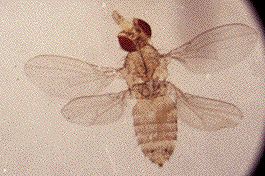Natural selection and variation - What is the source of new variation?

Mutation
A mutation is any change occurring in the message that a gene carries. Mutations mainly arise as copy errors when DNA is replicated at mitosis and meiosis. The fruitfly pictured here has suffered a dramatic mutation, called a macro mutation, and has an extra pair of wings.
The first theoretician of mutation was H.J. Muller, who recognised that the rate of mutation in nature is extremely low, and that they are almost always deleterious to the fitness of the organism. The accumulation of deleterious mutations places a mutational load on the population.
However, Darwinian evolution requires a constant supply of variation: much of it is supplied by mutation. Mutation may occur at either chromosomal or base level, and the latter is illustated in the following animation.
| Next |



